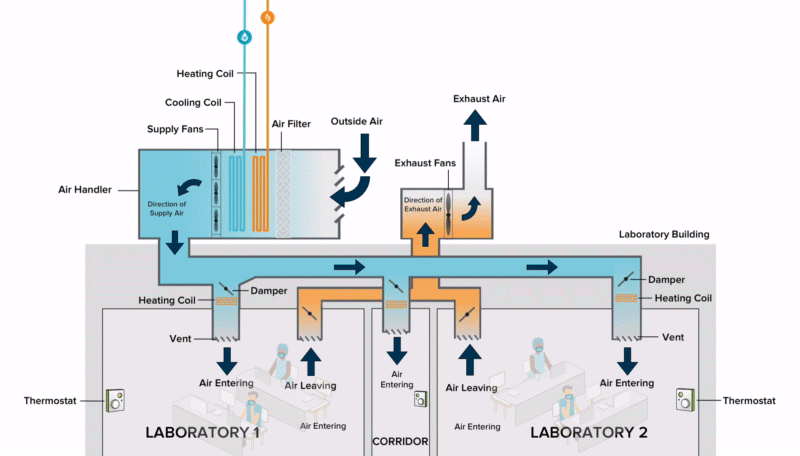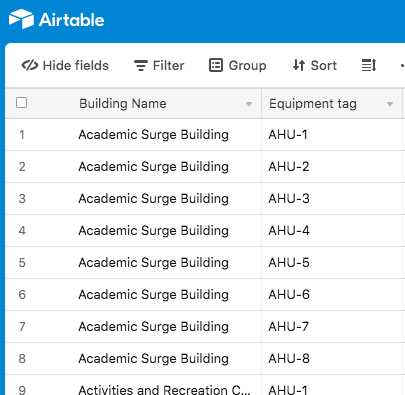Building Ventilation and Filtration
This webpage provides information about the heating, ventilation, and air conditioning (HVAC) systems in our campus buildings and how they are managed to support indoor air quality, comfort, and overall building performance.
On this page
UC Davis continually monitors and maintains ventilation and filtration systems to ensure they operate effectively and meet current standards for indoor environmental quality.
Because many campus buildings are connected to centrally managed HVAC systems, individual occupants have limited ability to adjust ventilation or filtration settings. Facilities Management regularly evaluates these systems on a building-by-building basis, with priority given to higher-occupancy spaces.
HVAC Systems
Heating, ventilation, and air conditioning (HVAC) systems play a critical role in maintaining indoor air quality and comfort in campus buildings. These systems help regulate temperature, control humidity, and circulate and filter air to support a healthy and productive indoor environment.
One important function of HVAC systems is managing air exchange, which affects how quickly indoor air is refreshed with outdoor air or filtered recirculated air.
1. Air Exchange Rates
Air exchange rates determine how often the air in a room is replaced or filtered. This rate is typically measured in air changes per hour (ACH). In most campus buildings, air exchange rates vary depending on the space and the type of HVAC system in use. For example, offices generally experience around 4 air changes per hour or less, while laboratories typically have around 6 air changes per hour.
2. Ventilation
Ventilation is the intentional introduction of outside air into a space to improve air quality. Many HVAC systems recirculate some air to save energy, and mix in some outdoor air based on the code requirements for the space type and its designed occupancy (a typical ventilation rate is 15 cubic feet per minute of outdoor air, per person.) In these systems, both the outdoor air and the recirculated indoor air are filtered by the HVAC system before being supplied to the occupied spaces.
Other HVAC systems (primarily those serving lab and animal spaces) operate at 100% ventilation rates, meaning they supply only outside air to occupied spaces and do not recirculate any air.

See how heating and cooling works in different types of spaces.
Check out animated graphics of HVAC systems in laboratory (wet labs) and non-laboratory buildings to see how they bring in ventilation and filter air supplied to occupied spaces.
3. Filtration
We also maintain air conditioning and ventilation systems and replace air filters on a schedule throughout the year. Filtration further mitigates risk of transmission in buildings with recirculated air. As air moves through a building's HVAC system, air filters trap and collect large and small particles such as dust, allergens and microorganisms.
Many of our buildings are already served by systems with MERV 13 rated filters. Systems with lower rated filters (typically MERV 8 or 11) are being evaluated for upgrade where feasible. Upgrading HVAC system filters is not always feasible due to system limitations.
- Learn more about MERV Filter Ratings
- MERV stands for minimum efficiency reporting value (MERV) and the rating number is a measure of how effectively the filter stops dust and other contaminants from passing through the filter and into the air stream. Filters with higher MERV ratings are denser and trap small particles more effectively than filters with lower MERV ratings.
In general, filters with a rating of MERV 16 or below are considered to be HVAC-system-grade filters for residential, commercial and general hospital use. MERV 17 through MERV 20 filters are typically used in surgical operating rooms, clean rooms and other contexts that require absolute cleanliness.
4. HVAC System Evaluation
Below you will find a link to more information about the specific ventilation and filtration levels of the HVAC systems serving campus buildings. Systems serving classrooms are listed first.

Building-Specific Information
Key: RA = recirculated air and OA = outside air
Drill down to learn more about the ventilation and filtration units in hundreds of campus buildings in this table created by Facilities Management's Energy and Engineering office. This team will continue to add details including descriptions of the specific areas served.
If your building is not listed, if you need more information about the unit serving a specific room or area in your building or you have questions about your HVAC equipment's settings and capabilities, please contact us.
- Submit a Work Order online
- Email facilities@ucdavis.edu
- Call (530) 752-1655
5. Desk and Floor Fan Use
Desk and floor fans can help improve comfort and air circulation in indoor spaces. However, their use should be considered carefully, especially in shared environments. Fans that blow air directly between people can unintentionally redistribute air in ways that may be undesirable or disruptive.
If used, fans should be positioned to enhance overall room airflow—such as by directing air toward exhaust vents or away from occupants—rather than blowing directly from one person to another. For ventilation purposes, fans are most effective when placed to draw in outdoor air or help exhaust indoor air, rather than simply recirculating it.
6. Opening Windows & Doors
This may be possible depending on your space, but you’re encouraged to consider that:
- Opening a window or propping a door open may not necessarily improve air circulation (e.g., it depends on outdoor air currents and whether a cross-draft can be achieved by opening windows or doors on opposite sides of room).
- Opening a window or door may interfere with the ventilation provided via the HVAC system by changing the pressurization or air balance of the room. It could also cause other spaces served by that system to be overcooled or overheated if unconditioned outdoor air affects a thermostat.
- Opening windows and doors presents other security and cleanliness issues (e.g., dust, particulates).
For fire prevention and life safety reasons, do not prop open:
- Entry doors
- Security access doors
- Fire doors | read SafetyNet on fire door regulations
- Laboratory doors
- Doors to rooms with fume hoods
Before propping open doors, please consult Fire Prevention Services at fireprevention@ucdavis.edu or (530) 752-1493.